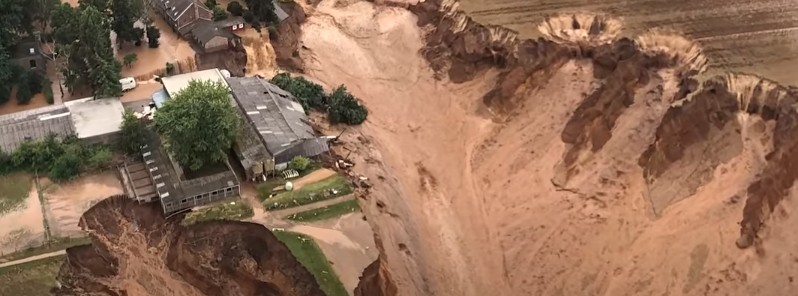Catastrophic floods in Germany claim lives of at least 184 people – country’s worst natural disaster since 1962

At least 184 people have been killed in Germany after record-breaking rains caused catastrophic flooding on July 14 and 15, 2021. Severe storms and deadly floods also hit neighboring countries, with the worst affected Belgium (42 fatalities), France, Luxembourg, Switzerland, the Netherlands, Italy (1 fatality), and Austria (1 fatality).
In western Germany alone, the worst-affected region, extremely heavy rains caused rivers to burst their banks, destroying roads, bridges, and homes. Numerous mudslides have contributed to the disaster which happened at an astonishing speed.
1 300 people had been initially reported as missing on July 16, but mostly due to mobile networks being down in some regions which made it difficult to call people. Most of the unaccounted for were in the northern part of Rhineland-Palatinate.
Leaking gas pipes and structural damage to buildings across the state have turned some sites into death traps and authorities have warned people not to go looking for missing relatives on their own but to leave it to rescue workers, DW reports.
Rhine-Westphalia minister said rescuers had carried out about 30 000 missions, airlifting people from flooded and destroyed homes and buildings.
For Germany, this was the deadliest natural disaster since the North Sea flood of 1962 and one of its worst natural disasters in history.



Parts of western Germany smashed numerous daily precipitation records going back 70 years.
The amount of rain that usually falls over the space of two months fell in just twelve hours in some parts of eastern Germany and northwestern France, said Frederic Nathan, a forecaster with Meteo-France.
Cologne registered 154 mm (6 inches) of rainfall over a 24-hour period, breaking the previous record of 95 mm (3.7 inches). The Kall-Sistig weather station in North Rhine-Westphalia recorded 144.8 mm (5.7 inches) during the same period, breaking the previous record of 82.7 mm (3.2 inches) set in 1947.
In just 9 hours, Reifferscheid near Bonn received 207 mm (8.1 inches).
"We have seen five or six cold spells since the beginning of June, which is something quite rare for this time of the year that we have certainly not seen in recent times," Nathan said, as reported by Bloomberg.
The slow moving persistent upper-level low that brought the long-lasting intense rainfall which caused the deadly #flooding in Germany & many parts of W Europe this week can be clearly in satellite imagery. First this loop of Airmass RGB & @HydroSAF precip rate 1/2 pic.twitter.com/dbOVRJjCfS
— EUMETSAT Users (@eumetsat_users) July 16, 2021
More than 1,000 people are missing in flood-stricken regions of western Germany and Belgium, where waters were still rising with the death toll already well over 100 and communications in some areas cut https://t.co/YkopON0QVg pic.twitter.com/3SqXOjUbng
— Reuters Pictures (@reuterspictures) July 16, 2021
Germany floods: Roads are flooded or broken apart. The army, emergency responders, and volunteers from nearby towns help clean up streets in affected areas. Residents and officials share their shock at the ferocity of the disaster.
Video report —https://t.co/CcMQ54XbOT pic.twitter.com/Q1iKw5Y0pl
— DW News (@dwnews) July 17, 2021
Europe floods: More than 125 people have died in Western Europe, with Germany bearing the brunt of the devastation. Rescue operations continue.https://t.co/pB4yqPiUeo pic.twitter.com/E3BHNKGXT8
— DW News (@dwnews) July 17, 2021
At least 42 people were killed in Belgium.
"We are still waiting for a definitive toll, but it could be that this flood becomes the most catastrophic our country has ever known," Belgian Prime Minister Alexander De Croo said.
The heaviest rains fell in eastern Belgium, with 271.5 mm (10.69 inches) of rain over 48 hours in the municipality of Jalhay, in the province of Liège — an absolute record for Belgium and almost three times the average rainfall over one month in this location for July. In the town of Spa, also in Liège, 217 mm (8.5 inches) of rain fell over 48 hours. (Lavenir)
While there were no casualties reported in Luxembourg, the country was still on Red Flood Alert on July 16 after record-breaking rains forced evacuations on July 15.
According to MeteoLux, more than 74 mm (2.91 inches) of rainfall was registered in a 12-hour period and almost 80 mm (3.1 inches) in 24 hours on July 15, breaking the previous July rainfall record set on July 22, 2016, at 69 mm (2.71 inches) and 71 mm (2.79 inches), respectively.
Hannah Cloke, a hydrologist who set up and advises the European Flood Awareness System (EFAS) said the system has issued an 'extreme' flood warning earlier this week but parts of Europe were not prepared for the deluge.
Cloke told Politico the disaster was 'a monumental failure of the system.'
"I would have expected people to be evacuating, you don’t expect to see so many people dying from floods in 2021. This is very, very serious indeed," she said.
"The EFAS issued a warning in the 'extreme category,' Cloke said, "which means there's a danger to life. It doesn't say you should evacuate, that's up to the national authorities. But typically, if you have a danger to life warning, and you know where that's going to happen, you make sure that you're in place for evacuation. That’s how disaster risk management works."
Featured image credit: Guardian (stillshot)

Commenting rules and guidelines
We value the thoughts and opinions of our readers and welcome healthy discussions on our website. In order to maintain a respectful and positive community, we ask that all commenters follow these rules.